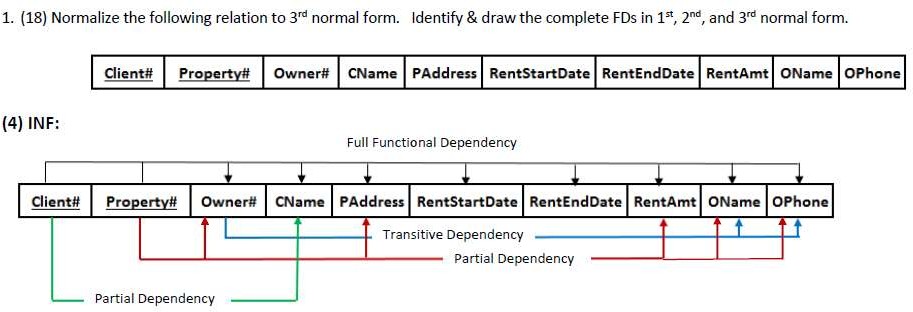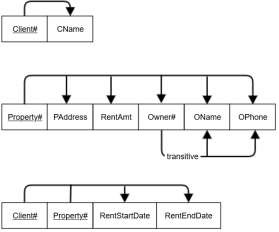(Solved): CIS 365 Business Database Concepts W3A1 - Normalization / Logical Design (58 points)...

CIS 365 Business Database Concepts W3A1 - Normalization / Logical Design (58 points)
The following assignment is to be drawn using Gliffy. Identify and label all functional dependencies and primary keys in each FD diagram. Copy/paste your diagrams to a Word doc, save as a .pdf, and submit it.
Make sure all work is clear and easy to read. Professional quality is expected. Use the methods shown in videos for drawing both the dependency diagrams and the logical database schema. Do not overlap the dependency lines; color-code lines to make them easier to follow.
- (18) Normalize the following relation. Identify & draw the complete FDs for all normal forms through to 3NF.
Application Summary: clients rent properties from their owners for a determined amount of time. This entity shows the client who rented the property (along with other info about the rental that must be recorded). Primary keys for the entity are identified on the diagram below. (Do not add or delete any attributes or keys).
CName – Client’s Last Name PAddress – property’s address
OName – owner’s last name OPhone – owner’s phone
RentStartDate – when client moves in RentEndDate – when client moves out (not predetermined)
RentAmt – the value that the property is rented – same for any client
 |
-
- (4) Identify all full (above the diagram), partial, and transitive dependencies (below the diagram) and label them.
- (3) Improve the relations to 2NF. Show and label all FDs and all dependency arrows. Identify all primary keys for each FD.
- (4) Improve the relations to 3NF. Show and label all FDs and all dependency arrows. Identify all primary keys for each FD.
- (7) Draw the relational schema for the final database table structure. Name each relation and identify all primary and foreign keys.
- (18) Normalize the following relation. Identify & draw the complete FDs for all normal forms through to 3NF.
Application Summary: customers rent boats from a charter company for a determined amount of time. This entity shows the customer who rented the boat, the date rented and the rental charge. It also shows the ownership of the boat. Primary keys for the entity are identified on the diagram below. (Do not add or delete any attributes or keys).
 |
-
- (4) Identify all full (above the diagram), partial, and transitive dependencies (below the diagram) and label them.
- (3) Improve the relations to 2NF. Show and label all FDs and all dependency arrows. Identify all primary keys for each FD.
- (4) Improve the relations to 3NF. Show and label all FDs and all dependency arrows. Identify all primary keys for each FD.
- (7) Draw the relational schema for the final database table structure. Name each relation and identify all primary and foreign keys.
- (22) Use the Invoice table structure shown below to answer the following questions:
Application Summary: Customers buy items for their pets at the local pet store. The store likes to keep information about the pets and what was purchased for them. The store is having some troubles with this table design and is giving you a small section of past data to help you redesign the invoice data. Primary keys for the entity are identified on the diagram below. (Do not add or delete any attributes or keys).
 |
- (5) Identify all full (above the diagram), partial, and transitive dependencies (below the diagram) and label them.
- (3) Improve the relations to 2NF. Show and label all FDs and all dependency arrows. Identify all primary keys for each FD.
- (5) Improve the relations to 3NF. Show and label all FDs and all dependency arrows. Identify all primary keys for each FD.
- (9) Draw the relational schema for the final database table structure. Name each relation and identify all primary and foreign keys.
Expert Answer
Functional Dependencies and Normalization (58 points)
 |
2NF:
 |
Buy This Answer $15
-- OR --
Subscribe $20 / Month
